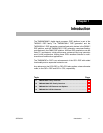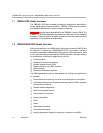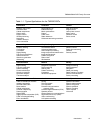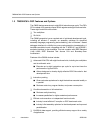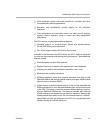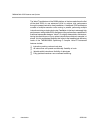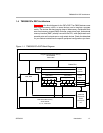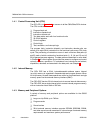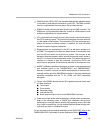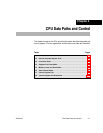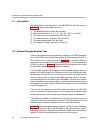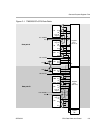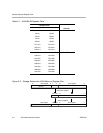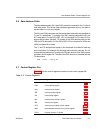
TMS320C67x DSP Architecture
1-9IntroductionSPRU733
DMA Controller (C6701 DSP only) transfers data between address ranges
in the memory map without intervention by the CPU. The DMA controller
has four programmable channels and a fifth auxiliary channel.
EDMA Controller performs the same functions as the DMA controller. The
EDMA has 16 programmable channels, as well as a RAM space to hold
multiple configurations for future transfers.
HPI is a parallel port through which a host processor can directly access
the CPU’s memory space. The host device has ease of access because
it is the master of the interface. The host and the CPU can exchange infor-
mation via internal or external memory. In addition, the host has direct
access to memory-mapped peripherals.
Expansion bus is a replacement for the HPI, as well as an expansion of
the EMIF. The expansion provides two distinct areas of functionality (host
port and I/O port) which can co-exist in a system. The host port of the
expansion bus can operate in either asynchronous slave mode, similar to
the HPI, or in synchronous master/slave mode. This allows the device to
interface to a variety of host bus protocols. Synchronous FIFOs and
asynchronous peripheral I/O devices may interface to the expansion bus.
McBSP (multichannel buffered serial port) is based on the standard serial
port interface found on the TMS320C2000™ and TMS320C5000™
devices. In addition, the port can buffer serial samples in memory auto-
matically with the aid of the DMA/EDNA controller. It also has multichannel
capability compatible with the T1, E1, SCSA, and MVIP networking
standards.
Timers in the C6000 devices are two 32-bit general-purpose timers used
for these functions:
Time events
Count events
Generate pulses
Interrupt the CPU
Send synchronization events to the DMA/EDMA controller.
Power-down logic allows reduced clocking to reduce power consumption.
Most of the operating power of CMOS logic dissipates during circuit
switching from one logic state to another. By preventing some or all of the
chip’s logic from switching, you can realize significant power savings with-
out losing any data or operational context.
For an overview of the peripherals available on the C6000 DSP, refer to the
TM320C6000 DSP Peripherals Overview Reference Guide (SPRU190).



